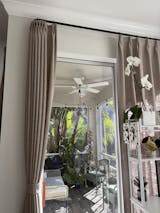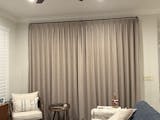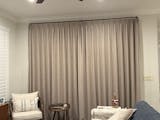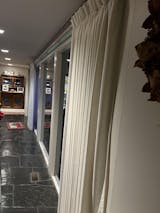The Art of Drapery
By Caitlin Fitch
Window treatments are the frosting on the cake of any space, but there’s an art to getting them right so they look like a professional Designer planned them. Follow these easy steps below when considering your next drapery purchase.
Height
You’ll want to plan the height of your panels ahead of time before placing your order on a semi-custom window treatment site like, TWOPAGES. For that really tailored look, your panels should “kiss” the floor or slightly puddle on the floor depending on the look you are going for. When we say “kiss” the floor we are taking the panel to about ¼” above the floor. To calculate your overall height, you should plan to have your panels hang from at least 6” above the window trim. This is especially important for rooms with lower ceilings (standard 8 ft), as mounting the drapery rods closer to the ceiling creates the illusion of height. You can apply these same rules to arched windows.

Width
When determining what width to order your panels in use this rule of thumb: each panel should equal at least 1-1.5x the width of the window panel. For a fuller look, each panel should equal 1.5-2x the width of the window panel. Some fabrics hang differently than others (i.e. Sheers vs. Linens); lighter fabrics typically require more fullness, while heavier materials may require less. Next you’ll want to ensure your drapes hang 6-10” past the window frame.

From: Photographer, Erin Kestenbaum
Layering
Depending on the space you will require different levels of privacy. You can always opt to back your panels with a range of room darkening material to achieve the desired light filtration you need. However, to quickly elevate the space consider layering your window treatments. For rooms that don’t require as much darkness you can layer sheer panels behind your primary panels or instead of shades on the windows you can add a roman shade to provide added privacy for a more elevated look.

From: Photographer, Erin Kestenbaum
Decorative Trim
To trim or not to trim is the question. Well, it depends on the style and overall aesthetic of the space and the fabric you’ve chosen for your drapery. Trim typically gives your drapery and instant custom upgrade so if the room calls for it, I always say go for it! If you purchase semi-custom drapes or readymade drapery, then adding trim is a quick way to elevate your panels. You can iron on decorative tape yourself at home or you can have a drapery seamstress adhere your chosen tape or trim.
Hardware
Your hardware should complement the style of the room and the drapes. For heavier drapery fabrics like velvets or chenilles you’ll want to use a heavier, decorative rod that can hold the weight, while lighter cottons or sheers can be hung on daintier, lightweight rods.

From: Photographer, Erin Kestenbaum




























Leave a comment